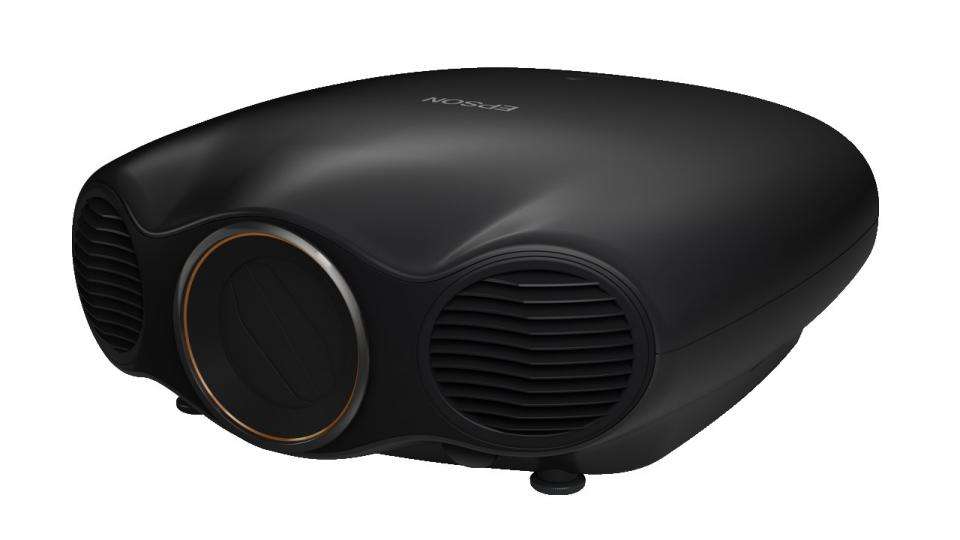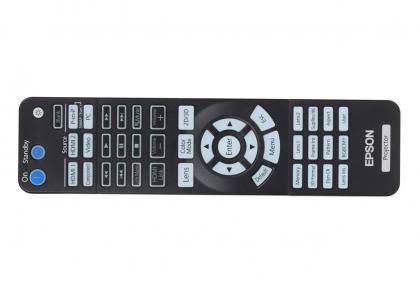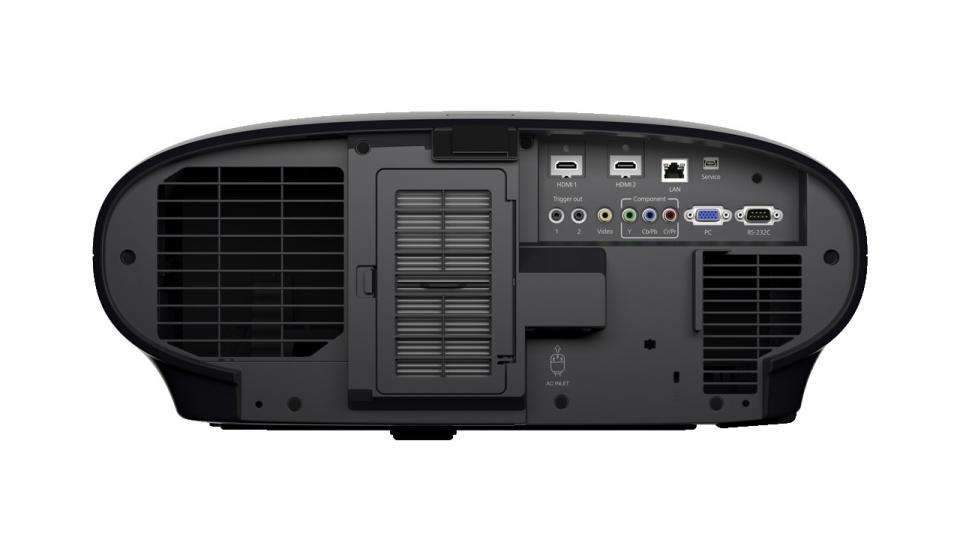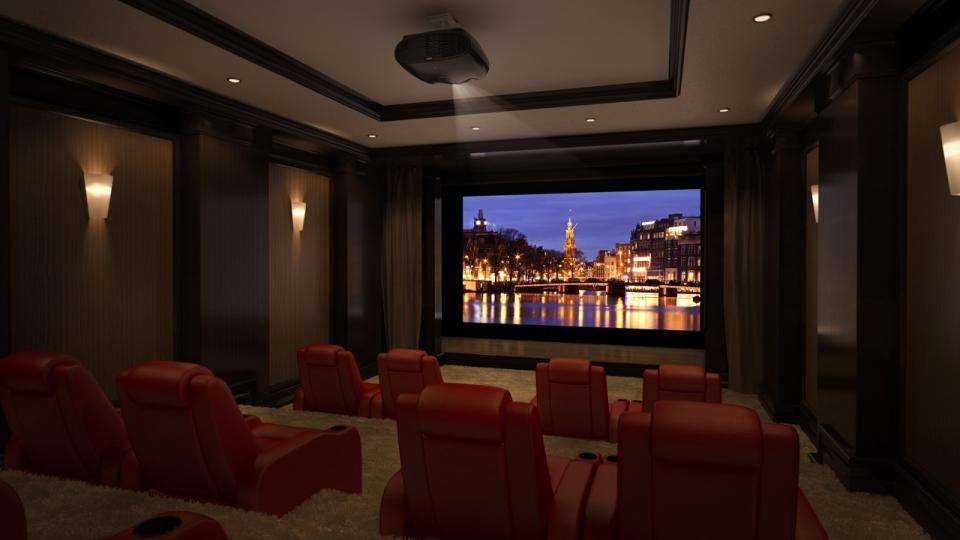Ultra HD content is only just starting to make small leaps into the mainstream, which presents a difficult decision for anyone buying a projector today. 4K projectors currently feel like expensive future proofing, with no native 4K content available, yet it would be naïve to buy a Full HD model with 4K just around the corner. The gigantic Epson EH-LS10000 throws another variable into the mix: 4K enhancement.
Features
This projector can take Full HD content such as Blu-ray discs and games, and through some impressive technical wizardry, "enhance" it so it looks like 4K, remastering the final result into a 3,840x2,160 resolution image. This is done by producing two images for every projected frame, with one frame shifted diagonally by half a pixel. Because they are produced and replaced so quickly, they appear as one single frame. While this doesn't necessarily lead to a better quality image by itself, complex algorithms that detect the edges of objects and fine details such as hair and dirt create a well-balanced, detail-packed image.

Epson has also opted for a laser projection system instead of a conventional lamp. This has a huge impact both on image quality and on the life of the projector itself. Two blue lasers are used; one provides blue light while the second is turned yellow by passing through a spinning yellow phosphor wheel. This is then split again into red and green colours using dichroic mirrors. The theory is that you get more vibrant colours, deeper blacks, cooler running and instant start-up, with no warm-up procedure. However, when the lasers eventually deteriorate you won't be able to replace them, so you'll need a new projector.
One popcorn crumb of comfort is that this 30,000-hour lifespan equates to one two-hour film, every day, for a little over 41 years. Not having to replace bulbs that typically cost in excess of £300 will be a huge cost saving and should be taken into account.
Image quality
There are a total of ten image processing settings; 1 to 5 and 4K-1 to 4K-5. The first five use conventional image processing to create more detail and increase contrast, while the second set employs 4K enhancement – in theory giving detail levels an even bigger boost. However, there doesn’t seem to be one enhancement setting that suits all types of media, and what you prefer will be down to your personal tastes and what sort of content you watch.
In Blu-ray movies with lots of film grain, like our Star Trek test disc, the 4K enhancement options made everything look slightly less well defined and messier than the Full HD settings. The details of young Kirk's hair as he speeds down a desert road, for example, looked much less defined with 4K enhancement set to 2 when compared with Full HD enhancement set to 5. Even worse, turning up the 4K enhancement options to 5 left me with an unnatural and harsh-looking image that doesn't work in a darkened home cinema environment.
There were occasions where 4K enhancement was clearly the better choice, though, with a Nine Inch Nails concert revealing beads of sweat and incredibly sharp fine hair detail appearing far more defined than in native Full HD.
4K processing also eliminates the so-called "screen door" effect you see on most projectors, where the tiny gaps between the pixels on the LCDs are visible on your projection surface. Unless you're sitting extremely close to the screen, you're unlikely to notice them at all, though, so this benefit is admittedly very niche and shouldn't influence your buying decision.
In general, though, I preferred to max out the Full HD processing. Stars in the pitch blackness of space that appeared as blurry pinpricks without any image processing were transformed into bright and vibrant patches, while the sky around them remained inky black, thanks to the projector's incredibly high (although unspecified) contrast levels. Exterior daylight shots also looked incredibly vibrant.

I was impressed with the smooth, judder-free movement produced by Epson’s frame interpolation, which avoids becoming overbearing. There are multiple levels of processing, but the default option is easily the best; turning it down or off obviously leads to more judder, and turning it all the way up will give you a "soap opera" effect, with everything looking uncomfortably smooth. 4K enhancement switches off this feature, but because of the rapid refresh rate, this has less of an effect than you might expect.
The EH-LS10000’s rated brightness is only 1,500 lumens, which is fine for a dark room, but is easily overcome by overhead lighting or natural light. You should invest in proper blackout curtains for your home cinema setup if you're spending £6,000 on a projector.
Two pairs of active shutter 3D glasses are included in the box. Generally, active shutter 3D results in dimmer images because the shutters physically "close" their liquid crystals, reducing the amount of light that makes it to your eye. The EH-LS10000 refreshes at 480Hz in 3D mode, so the shutters are closed for a very short time, meaning more light makes it to your eyes. This also means more vibrant images with very little crosstalk, even with objects that are in the extreme foreground. Avatar in 3D has never looked so alive.
Inputs and adjustments
As the EH-LS10000 isn’t 4K native, Epson hasn’t fitted HDMI 2.0 ports, but it has added HDCP 2.2 copy protection. This means that while it won’t project in Ultra HD (instead downscaling to 1080p then ‘enhancing’ to 4K), you will be able to plug in a 4K Blu-ray player when they eventually arrive.

VGA, component and composite video inputs, an RS-232c port for automation and a LAN port for diagnostics are included too. The projector can even be set up to send email notifications if a fault develops.
You also get a full complement of physical lens adjustments. There's lens shift, zoom and focus as well as keystone, all operated using the huge, backlit remote control. You can save up to ten lens configurations, which helps when you have a library of content in varying aspect ratios and you don't want to have to painstakingly adjust your projector each time you want to watch something in 2.4:1.
Conclusion
The EH-LS10000 is a tricky beast. Its lack of native 4K projection is a problem for those looking to jump straight on the 4K Blu-ray bandwagon as soon as possible, but its excellent (albeit fiddly) overall image quality is fantastic. What's more, its laser projection system has a 30,000-hour lifespan, meaning maintenance costs will be extremely low. For £500 less, however, you can buy the Sony VPL-VW300ES, which edges out the Epson in terms of image quality thanks to native 4K projection.
As a high-end Full HD projector, the Epson EH-LS10000 is brilliant, and if you're in the market for a Full HD device, it's a great buy. Just consider your options before you commit to several more years of Full HD content.
|
HARDWARE |
|
Projector type |
3-chip LCD, laser |
|
3D support |
Yes |
|
Contrast ratio |
Not stated |
|
Native resolution |
1,920x1,080 |
|
Native aspect ratio |
16:9 |
|
Throw ratio |
1.28-2.73:1 |
|
Max diagonal at 7ft distance |
76in |
|
Projection distance |
2.8-6m |
|
Optical zoom |
1-2.1 |
|
Mirror image |
Yes |
|
Invert image |
Yes |
|
Lens shift |
Motorised vertical 90%, horizontal 40% |
|
Video inputs |
2x HDMI |
|
Audio inputs |
Component |
|
Video outputs |
None |
|
Audio outputs |
None |
|
Noise (in normal use) |
19dB |
|
Internal speaker (power) |
No |
|
Card reader |
No |
|
Image formats read |
N/A |
|
Document formats read |
N/A |
|
Lamp life |
Not stated |
|
Lamp life in economy mode |
30,000 hours |
|
Lamp brightness |
1,500 lumen |
|
Size |
225x550x553mm |
|
Weight |
18kg |









